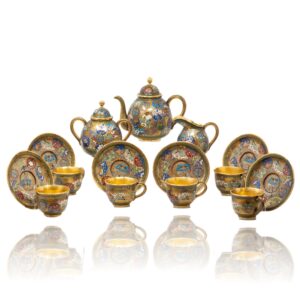Description
From Kyoto’s famed Kinkozan workshop, a Meiji-period Satsuma vase of exceptional enamel and gilt.
From our Japanese Satsuma collection, we are delighted to offer this superb Meiji period Satsuma vase by Kinkozan.
The vase of ovoid form with a slightly flared neck features a rich cobalt-blue ground, lavishly detailed with gilt scrollwork and stylised floral medallions. Two shaped panels encircle the body, each finely painted with different scenes of natural harmony.
One panel displays a stunning composition of wisteria, chrysanthemums, and bamboo with a small bird perched on a branch, a symbol of peace and seasonal renewal. The second panel shows a detailed arrangement of flowers in bloom beside a bamboo fence, rendered with exceptional balance and delicacy. Between these panels, the vase features a gilt dragon swirling among stylised clouds clutching a flaming pearl, representing strength and prosperity.
The upper neck is detailed with multiple fans and scrolling patterns, while the base bears the gilded Kinkozan seal mark both blind and painted reading 金光山造 Kinkozan Made.
Dating to circa 1890, this vase reflects the height of Kyoto Satsuma production during the Meiji era. The Kinkozan workshop was celebrated for its innovation in colour, form, and technique, becoming one of Japan’s most admired producers of export Satsuma.
A refined example of late-19th-century Japanese porcelain, this vase combines bold design with precise enamel work, perfectly capturing the visual language of Meiji Period Kyoto ceramics.
KINKOZAN 金光山
the Kinkozan family have been associated with pottery dating back to 1645. They went on to become the largest producer of Satsuma ware by one individual company, from the end of the 19th century until 1927 after which the factory closed. By the 1850s Kobayashi Sobei (1824-84), Kinkozan Sobei (artist name Kinkozan IV), started to export his products together with the Kyoto manufacturer Taizan VIII. The main target market was America with their main production period approximately between 1875-1927 under the leadership of Kinkozan V(1868-1927).
For further information please see our makers and retailers page on Kinkozan.
MEIJI PERIOD (1868-1912)
The Meiji era marked Japan’s transformation into a modern nation and a golden age of decorative arts. With the end of samurai rule and Japan’s opening to the West, artisans produced works of exceptional quality for both domestic and international audiences. Supported by the government through world fairs and Imperial commissions, Japanese lacquerware, cloisonné, satsuma ceramics, bronzes, and ivory carvings reached collectors worldwide. Many leading artists of the time, including Makuzu Kozan and Namikawa Yasuyuki, were honoured as Imperial Household Artists, ensuring the Meiji period remains one of the most celebrated eras of Japanese art.
For further information please see our article Japanese Meiji Period: Art, Collecting, and Cultural Transformation.
SATSUMA WARE
Satsuma ware originated in southern Kyūshū around 1600 and developed into one of Japan’s most recognisable ceramics. Early Ko-Satsuma pieces were rustic, dark-clay wares made for everyday use, while the later Kyō-Satsuma style became famous worldwide during the Meiji period.
Characterised by ivory crackled glaze, delicate overglaze enamels, and lavish gilding, export Satsuma appealed strongly to Western collectors. Designs often feature landscapes, flowers, figures, and scenes from Japanese life and mythology. Renowned artists such as Yabu Meizan, Ryozan, and the Kinkōzan workshop produced some of the finest examples, which remain highly sought after today. Genuine Satsuma can often be identified by the Shimazu crest, artist signatures, or the mark “Dai Nippon” used during the Meiji era.
For further information on the history of Satsuma Wear please see our article Japanese Satsuma Ware.
CHRYSANTHEMUM (KIKU)
The chrysanthemum, known as kiku (菊) in Japan, is one of the country’s most important symbols. Introduced from China in the 5th century, it quickly became associated with longevity, renewal, and autumn. By the 12th century, Emperor Go-Toba adopted the chrysanthemum as the crest of the Imperial family, where it remains today as the Imperial Seal of Japan, also called the Chrysanthemum Throne. The flower appears widely in art, poetry, festivals, and design, celebrated for both its seasonal beauty and its links to the virtues of loyalty, resilience, and honour.
For further information see our article Chrysanthemums in Japanese Culture: The Imperial Flower of Autumn.
WISTERIA (FUJI 藤) IN JAPANESE CULTURE
Wisteria, known in Japan as fuji (藤), has been admired for centuries as a symbol of elegance, longevity and nobility. During the Heian period (794-1185), the colour purple, which is closely associated with wisteria, was reserved for members of the imperial court and aristocracy. Wisteria also has practical and cultural importance through textile known as fuji-fu, made from the plant’s vines. It is one of the oldest fabrics in Japan and was designated a tangible cultural property in 1991. Since the Edo period, wisteria has been cultivated on trellises to create its distinctive flowering canopy, a tradition still seen in gardens today. It was also used historically in traditional medicine, adding to its layered cultural meaning.
MEASUREMENTS
22.5cm High x 13.5cm Diameter (8.86 x 5.3 Inches)
CONDITION
Excellent Condition
With every purchase from Jacksons Antique, you will receive our latest product guide, certificate of authenticity, full tracking information so you can monitor your shipment from start to finish and our personal no-hassle, money-back policy giving you that extra confidence when purchasing. Don’t forget to sign up to our free monthly newsletter for 10% off your first online purchase.

































